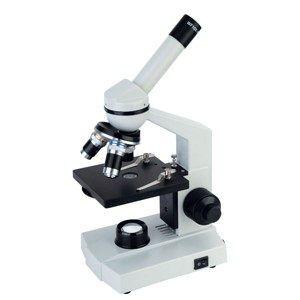What Factors Should I Consider When Choosing a Biological Microscope?

Choosing the right biological microscope depends on your specific needs and budget. Here are some key factors to consider:
l Magnification Power: Consider the level of magnification you need to view your specimens of interest. For basic cell observation, a microscope with 40x and 100x objective lenses might suffice. For viewing viruses or complex cell structures, a microscope with higher magnification (up to 1000x) might be necessary.
l Resolution: Resolution refers to the microscope's ability to distinguish fine details. Higher resolution is essential for observing very small structures or closely spaced features. Resolution is not just about magnification; it's also influenced by the quality of the lenses.
l Ease of Use: Some microscopes have features like coaxial focusing knobs (both coarse and fine adjustments move together) or objectives that click into place to make focusing and magnification changes smoother. These features can be especially helpful for beginners.
l Durability: Microscopes are an investment, so consider the build quality. A well-made microscope from quality materials will last longer and provide better performance. Look for a microscope with a sturdy metal stand and well-constructed components.
l Cost: Biological microscopes range in price from basic student models to complex research-grade instruments. Determine your budget and choose a microscope that offers the features and functionality you need at a price that fits your needs. Consider the cost of ownership, including replacement bulbs and any necessary accessories.
l Lighting: Microscope illumination can vary. Some have simple incandescent bulbs, while others have LED illumination. LED lighting offers several advantages, including whiter, brighter light, longer bulb life, and lower energy consumption.
l Stage Controls: The stage should allow for smooth and precise movement of the slide in both horizontal and vertical directions. Some stages have mechanical stage controls for easier positioning of the specimen.
l Condenser Lens: The quality of the condenser lens can impact image quality. Look for a condenser with an iris diaphragm for better light control.
l Brand Reputation: Consider purchasing a microscope from a reputable brand known for producing high-quality and reliable microscopes. These brands often offer better customer service and warranty options.
l Service and Warranty: Check the warranty offered by the manufacturer and the availability of repair services in your area. A longer warranty and readily available service can give you peace of mind.
Additional factors to consider:
l Intended Use: Are you using the microscope for educational purposes, hobbyist exploration, or professional research? The intended use will influence the level of features and complexity you need.
l Portability: If you need to transport the microscope frequently, consider its size and weight. Portable microscopes are available but may have some limitations in features or performance.
l Digital Imaging Capabilities: Some microscopes can be connected to digital cameras for image capture and analysis. If this is important for you, choose a microscope compatible with digital imaging attachments.
By carefully considering these factors, you can choose a biological microscope that meets your needs and budget, opening a window to the fascinating world of the unseen.
- Art
- Causes
- Crafts
- Dance
- Drinks
- Film
- Fitness
- Food
- Games
- Gardening
- Health
- Home
- Literature
- Music
- Networking
- Other
- Party
- Religion
- Shopping
- Sports
- Theater
- Wellness


